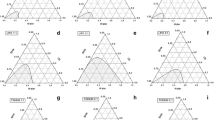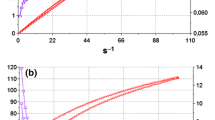Abstract
Dermal or transdermal medication may lead to irritant contact dermatitis. However, little information is available on the irritant effect of surfactants which are applied in topical formulations. Our aim was to examine the irritant effect of the most frequent compounds in topical products. A murine model was applied. The following compounds were examined: sodium lauryl sulphate (SLS), polyethoxylated (40EO) hydrogenated castor oil and sucrose laurate. SLS led to severe erythema, increase in transepidermal water loss (TEWL) and induced necrosis and accumulation of neutrophylic granulocytes and lymphocytes. Exposure to sucrose laurate resulted in an elevation of TEWL, but histology did not reveal impairment of the skin structure. Application of polyethoxylated (40EO) hydrogenated castor oil was not accompanied by tissue damage. Special attention should be paid to the irritant effect of SLS. Polyethoxylated (40EO) hydrogenated castor oil seems to be a non-irritant agent and sucrose laurate is also a promising candidate for application in topical preparations.
Similar content being viewed by others
References
Schaefer H, Redelmeier TE (1996) Skin barrier: principles of percutaneous absorption. Karger, Basel
Kanikkannan N, Singh M (2002) Skin permeation enhancement effect and skin irritation of saturated fatty alcohols. Int J Pharm 248(1–2):219–228
Hanifin JM (2009) Evolving concepts of pathogenesis in atopic dermatitis and other eczemas. J Invest Dermatol 129:320–322
Anderson FA (2011) Annual review of cosmetic ingredient safety assessments 2007–2010. Int J Toxicol 5Suppl 30:73S–127S
Ale I, Lachapelle JM, Maibach HI (2009) Skin tolerability associated with transdermal drug delivery systems: an overview. Adv Ther 26:920–935
Kano S, Sugibayashi K (2006) Kinetic analysis on the skin disposition of cytotoxicity as an index of skin irritation produced by cetylpyridinium chloride: comparison of in vitro data using a three-dimensional cultured human skin model with in vivo results in hairless mice. Pharm Res 23:329–335
Arndt KA, Hsu JTS (2006) Manual of dermatologic therapeutics, 7th edn. Lippincott Williams and Wilkins, Philadelphia
Mittal A, Sara UV, Ali A, Aqil M (2008) The effect of penetration enhancers on permeation kinetics of nitrendipine in two different skin models. Biol Pharm Bull 31:1766–1772
Nair A, Vyas H, Shah J, Kumar A (2011) Effect of permeation enhancers on the iontophoretic transport of metoprolol tartrate and the drug retention in skin. Drug Deliv 18:19–25
Lee CH, Maibach HI (1995) The sodium lauryl sulphate model: an overview. Contact Dermatitis 33:1–7
Agner T, Serup J (1990) Sodium lauryl sulphate for irritant patch testing—a dose-response study using bioengineering methods for determination of skin irritation. J Invest Dermatol 95:543–547
Lee EJ, Rothwell JT (2010) Histological changes to the skin of Merino sheep following deep dermal and subcutaneous injections of sodium lauryl sulphate. Aust Vet J 88:146–150
Feher A, Csanyi E, Csoka I, Kovacs A, Eros I (2005) Thermoanalytical investigation of lyotropic liquid crystals and microemulsions for pharmaceutical use. J Therm Anal Calorim 82:507–512
Horvat S, Feher A, Wolburg H, Sipos P, Veszelka S, Toth A, Kis L, Kurunczi A, Balogh G, Kurti L, Eros I, Szabo-Revesz P, Deli MA (2009) Sodium hyaluronate as a mucoadhesive component in nasal formulation enhances delivery of molecules to brain tissue. Eur J Pharm Biopharm 72:252–259
Csoka G, Marton S, Zelko R, Otomo N, Antal I (2007) Application of sucrose fatty acid esters in transdermal therapeutic systems. Eur J Pharm Biopharm 65:233–237
Lehmann L, Keipert S, Gloor M (2001) Effects of microemulsions on the stratum corneum and hydrocortisone penetration. Eur J Pharm Biopharm 52:129–136
Csizmazia E, Eros G, Berkesi O, Szabo-Revesz P, Csanyi E (2012) Ibuprofen penetration enhance by sucrose ester examined by ATR-FTIR in vivo. Pharm Dev Technol 17:125–128
Acknowledgments
The authors deeply thank Éva Sztanyik for her excellent assistance. The study was supported by TÁMOP-4.2.1/B-09/1/KONV-2010-000 and TÁMOP-4.2.1/B-09/1/KONV-2010-0005, further by NKTH-A*STAR Hungarian—Singaporean Bilateral S&T International Cooperation (BIOSPONA).
Author information
Authors and Affiliations
Corresponding author
About this article
Cite this article
Erős, G., Kurgyis, Z., Németh, I.B. et al. The Irritant Effects of Pharmaceutically Applied Surfactants. J Surfact Deterg 17, 67–70 (2014). https://doi.org/10.1007/s11743-013-1444-6
Received:
Accepted:
Published:
Issue Date:
DOI: https://doi.org/10.1007/s11743-013-1444-6




